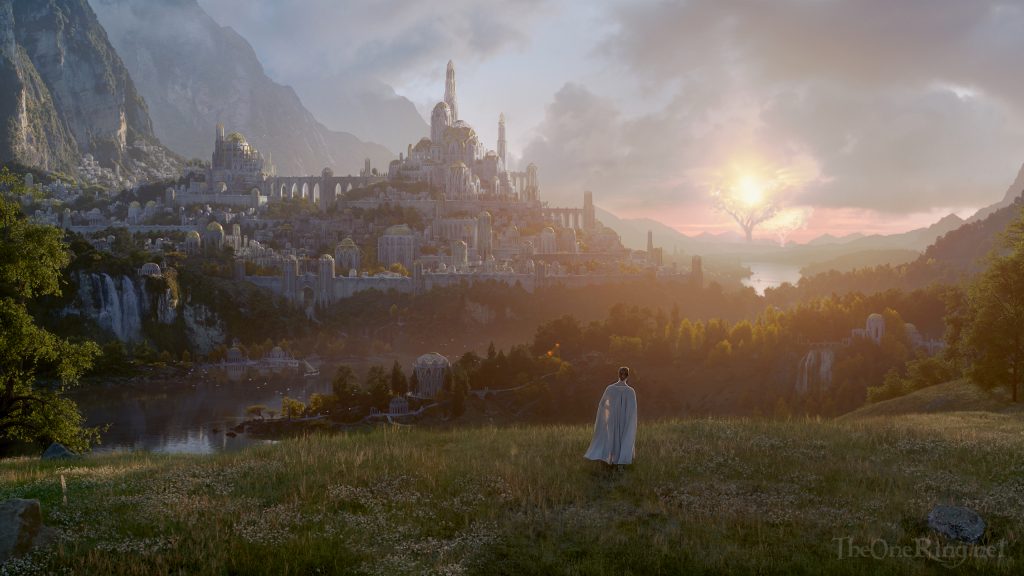Here’s a question. If you’re LOTR on Prime, and if your main series material is centered on the Second Age, why tease/lead with an image that show something from a vastly earlier period in the history of Tolkien’s world?
I’ve been pondering this a lot.
Unless LOTR on Prime has gone collectively mad, then there has to be a purpose — some link between that panorama, and the Second Age story that we know is coming.
So, let’s analyse that.

The location itself may offer a link.
Why? Because Númenor — much, much later — tries to invade Valinor. Problem is, that period of Númenor’s history has little to do with the dwarf-elf interactions we seem to be promised if spy reports are correct. So, it’s probably not Valinor itself that’s important, nor the Two Trees in themselves (sorry TREES! fans, I empathise).
That leaves the events that happen in Valinor, and the key protagonists in those events.
Events are — by and large — resolved by The War of Wrath. However, some of those protagonists remain and become involved in the new dramas of the Second Age in Middle-earth (and Númenor).
And I feel this could offer a clue to what’s going on.
Of the chief actors through the events of the Second Age, I can think of four (five, technically) who are also players in during the final Years of the Trees.
Sauron
The first is Sauron. But the link between Sauron and Valinor/The Two Trees is tenuous to non-existent. According to The Silmarillion, he rebelled much earlier and then spent much of Melkor’s imprisonment lurking in and around Angband. He doesn’t really feature strongly in First Age events until Beren and Lúthien’s quest.
Neither the trees — nor any of the events that occur around them — are useful to solidify the background of Sauron for the audience. If you wanted to use Sauron as a link, you’d need to begin somewhere else. For this reason I eliminate Sauron.
Galadriel and Celeborn
The next two come as a pair: Galadriel and Celeborn.
Here, it’s a twofold opportunity.
One, it’s a way to establish Galadriel’s prominence among the Noldor, and the strength of her ambition. Recall Galadriel’s role in the rebellion of the Noldor and their exile. Fëanor is instigator, but in the Silmarillion version she is also involved:
Galadriel, the only woman of the Noldor to stand that day tall and valiant among the contending princes, was eager to be gone. No oaths she swore, but the words of Fëanor concerning Middle-earth had kindled in her heart, for she yearned to see the wide unguarded lands and to rule there a realm at her own will.
Of the Flight of the Noldor, The Silmarillion.
My thinking is that portraying some of Galadriel’s early life in Valinor could be used as a way to support her desire and capacity to (at least to according one tradition outlined in Unfinished Tales) establish Eregion much later in the Second Age with the assistance of Celeborn.
It would also serve to underpin — whether through continued pride, or Ban (or both) — why she did not return to Valinor for so long. There’s vast amounts of drama to be wrung here should LOTR on Prime do it right. A sort of “How I became a massive troublemaker and learnt to love the Ban” sort of thing.
Galadriel is also LOTR on Prime’s most natural and relatable link to Peter Jackson’s movies: well-liked and well-remembered even among those who aren’t Lord of the Rings aficionados.
Celebrimbor
Next is Celebrimbor. To my surprise (for I wasn’t aware of it until very recently), Tolkien outlined that Celebrimbor was born in Valinor during the Years of the Trees, not in Beleriand during the First Age. That he subsequently followed his father, Curufin, into exile, while his mother remained behind, suggests to me that he was well into adulthood by the time of the Noldor’s rebellion against the Valar.
His identity as the grandson of Fëanor makes him a close witness to events in Valinor while his (presumably) growing talents as a smith and craftsmen can be contrasted against the immense skill of Fëanor (and Galadriel). In particular, Fëanor’s achievements with the Silmarils could be used as a dramatic spur for his own creations.
For Celebrimbor, Eregion is not so much a place to rule but a place where he can be free to create with the ultimate aim of someday surpassing the works of his grandfather. Celebrimbor is also a more natural tie for recent spy reports of dwarves and elves meeting. Unless it’s a very frosty meeting, that’s not very likely to be one involving Galadriel and Celeborn (even if Galadriel is not entirely unreceptive to dwarves).
Glorfindel
Glorfindel is the final option. Also an exile, also born in the Years of the Trees. Coincidentally, also blonde. As The Fellowship of the Ring describes it, “his hair was of shining gold”.
Moreover, Glorfindel returns to Middle-earth sometime during the Second Age to play a role in helping keep Sauron at bay after he forges the One Ring. Tolkien writes that this was probably sometime between SA1200 and SA1600 though, and I wonder whether even the first full season would get that far.
Any other elf is a poor fit.
Cirdan did not make the journey to Valinor. Gil-galad is too young — born near the end of the First Age in Beleriand. Elrond is in the same boat. And the rest of the chief Noldorin exiles either died in the long wars against Melkor, or returned to Valinor at the conclusion of the War of Wrath.


